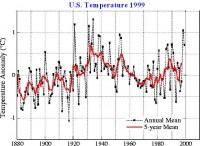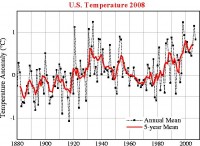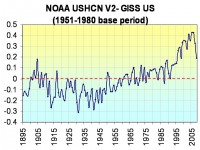By Joseph D’Aleo, CCM, AMS Fellow
Issues with the United States and especially the global data bases make them inappropriate to use for trend analysis and thus any important policy decisions based on climate change. These issues include inadequate adjustments for urban data, bad instrument siting, use of instruments with proven biases that are not adjusted for, major global station dropout, an increase in missing monthly data and questionable adjustment practices.
NOAA NCDC USHCN - US CLIMATE DATA
When first implemented in 1990 as USHCN version1, it employed 1221 stations across the United States. In 1999, NASA’s James Hansen published this graph of USHCN version 1 annual mean temperatures:

About which Hansen correctly noted: “The U.S. has warmed during the past century, but the warming hardly exceeds year-to-year variability. Indeed, in the U.S. the warmest decade was the 1930s and the warmest year was 1934.”
USHCN was generally accepted as the world’s best data base of temperatures with the stations most continuous and stable, and adjustments made for time of observation, urbanization, known land use changes around sites, and instrumentation changes, each of which can produce major contamination issues for temperature data.
NOAA NCDC removed the urbanization adjustment of Karl et al (1988) in version 2 in 2007. GISS continues to adjust US data for urban heat islands using the satellite determined brightness which categorizes stations as rural, small towns and cities. Here is the latest GISS plot of the US temperatures.

See larger image here.
The difference between the NOAA NCDC USHCN version 2 and GISS shows that NOAA’s new algorithm fails to correct for urbanization warming. In fact the NCDC changes have introduced a warming of 0.75F in the 75 years since 1930. Man made warming indeed but the men are in Asheville, NC.

See larger image here.
See in the linked PDF how this and other issues creates serious questions about the NOAA US data. Also see how GISS urban adjustment globally fails the test largely because of the lack of accurate metadata (population, siting particulars etc) with about as many urban areas adjusted up as down and how NOAA GHCN and Hadley CRUT3v perform no UHI adjustment but accounts for urbanization by simply increasing the uncertainty by a mere 0.1C per CENTURY.
See how all the other issues most notably major station dropout and missing data, bad siting equipment issues make all the global data bases completely unreliable for trend assessment or for policy decision making. The only reliable data base is the satellite MSU (RSS and UAH) but unfortunately it goes only back to 1979.
My thanks to Ken Gregory of Friends of Science for providing a synopsis of the many excellent and relevant posts by Steve McIntyre on GISS data and of course to Steve and Anthony Watts for their superb work that benefited this report. Again see pdf here.




